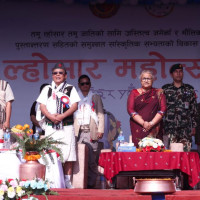- Tuesday, 30 December 2025
Snow leopard found in Morang was from high mountain, research shows
Kathmandu, Oct. 10: On January 23, 2024, a snow leopard, usually found in high altitudes, was spotted in Charghare of Urlabari, Morang district, at a very low elevation of just 146 metres. This rare sighting has left wildlife experts and conservationists puzzled.
This is the first recorded sighting of a snow leopard at such a low altitude, raising critical questions about wildlife behaviour, habitat fragmentation and the impact of climate change on animal movements. Snow leopards typically inhabit elevations ranging from 3,000 to 6,000 meters.
At the same time, there were many rumours that the snow leopard, (Panthera uncia), a flagship species of the mountainous regions in South and Central Asia, was brought there for smuggling by the poachers. Soon after the rescue, the snow leopard was brought to the Central Zoo for treatment and examination.
To determine the exact reason for the sighting of the snow leopard in such lowland areas, a team of experts, including officials from the Sub-division Forest Office, Urlabari and the National Trust for Nature Conservation-Koshi Conservation Centre (NTNC-KCC) visited the snow leopard’s first sighting location.
A peer-reviewed research paper “An unusual lowest elevation record of snow leopard (Panthera uncia) in Nepal”, has been published in Snow Leopard Reports Journal, Sweden (publicera.kb.se), on Tuesday. Expert team members, including snow leopard specialists Dr. Madhu Chetri, Birendra Gautam, Naresh Subedi, and Chiranjibi Prasad Pokharel, conducted a field survey from January 28 to 30, 2024. They concluded that the snow leopard had ended up in the area after losing its way from its original habitat, maybe from the Kanchenjunga Conservation Area.
As per their field observation, Dr. Chetri, chief at the NTNC Chitwan, said that the snow leopard was first spotted by a local farmer in a mustard field around 9:30 AM on the same day. Mistaking the elusive big cat for a domestic animal, the farmer threw a mud chunk at it, prompting the leopard to flee into a nearby bamboo thicket. The farmer, realising his mistake, quickly raised an alarm, and within hours, 400 locals had gathered to encircle the frightened animal.
Armed with bamboo sticks, they attempted to trap the leopard. The tense situation lasted for several hours until the Division Forest Office and technicians from the National Trust for Nature Conservation (NTNC) arrived at the scene, he said.
“Upon rescue, the snow leopard was found to be injured and weak. Weighing just 37 kilograms, the young male, estimated to be between 1.5 to 2 years old, was immediately transported to the NTNC-Central Zoo Animal Hospital for treatment,” he said.
According to him, its claws were intact, and no significant dental or body injuries were found. Despite the leopard’s physical resilience, the incident revealed the fragility of its situation.
For three days following its capture, the snow leopard was under constant CCTV surveillance. During this period, they carefully observed its behaviour and dietary patterns. The leopard displayed shy and elusive tendencies. Over the days, it showed a slow and cautious approach to its meals, primarily consisting of chicken and exhibited signs of interest as it explored its surroundings within the enclosure.
According to Dr. Chhetri, “Further insights into its dietary habits were obtained through scat analysis. Hair samples revealed that the leopard had recently consumed naur (blue sheep), a species found only at elevations above 3,000 meters in the Nepali Himalayas. This finding indicated that the snow leopard had descended from much higher altitudes in search of food or refuge.
In addition to the naur, the leopard’s scat also contained rodent hairs and claws, suggesting a diverse diet during its journey to the lowlands.”
Nepal’s snow leopards face an increasingly complex set of challenges as their habitats are threatened by human encroachment, climate change and environmental degradation, he said.
The snow leopard’s sighting in Urlabari, located nearly 50 kilometres from the nearest mountain range, highlights the urgency of addressing these barriers, he said.
The sighting of a snow leopard in the lowlands of Nepal is both a cause for concern and an opportunity for scientific discovery, the research team concluded.
Meanwhile, discussing the re-wilding of the snow leopard, Dr. Ramchandra Kandel, Director General of the Department of National Parks and Wildlife Conservation, said that the leopard has been in the Central Zoo for a long time. “If we consider re-wilding, we need to assess its chances of survival and whether it can hunt prey. After spending such a long time in captivity, it will be challenging for the animal to adapt to the wild again.”
On the other hand, Dr. Chetri suggested that the snow leopard could remain in the Central Zoo for educational and research purposes. “It is a gift from nature, allowing people who may never see them in the wild to study and observe this magnificent creature,” he added.




-square-thumb.jpg)












